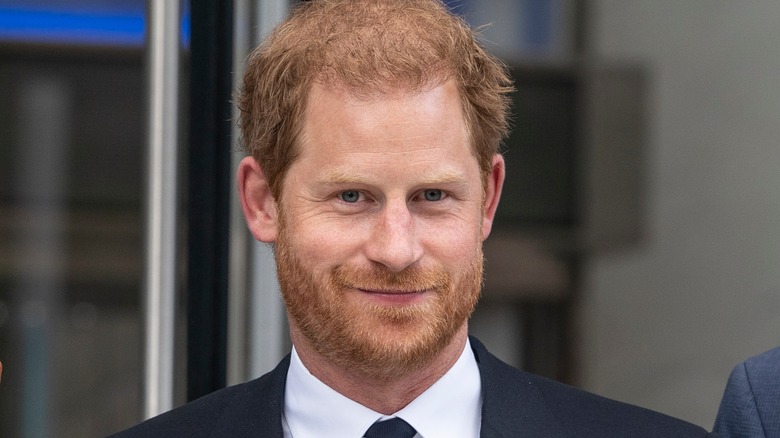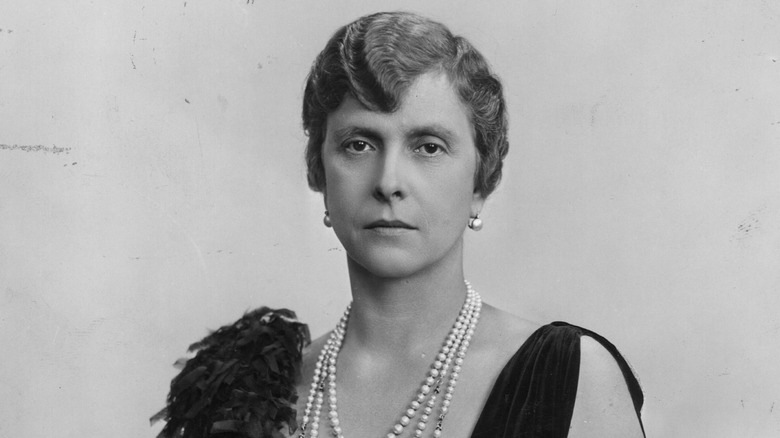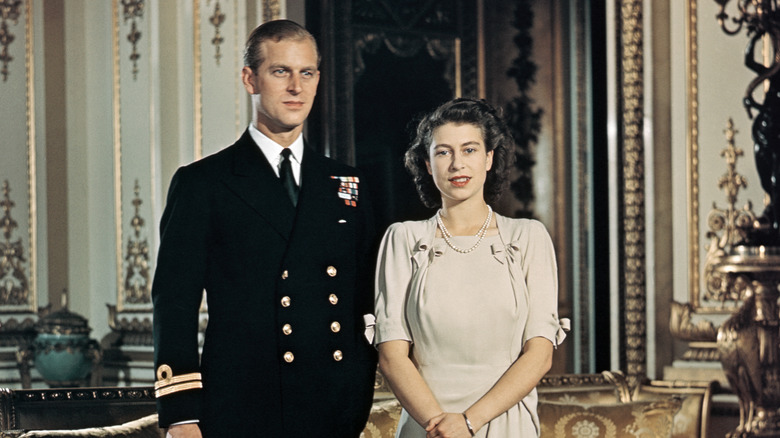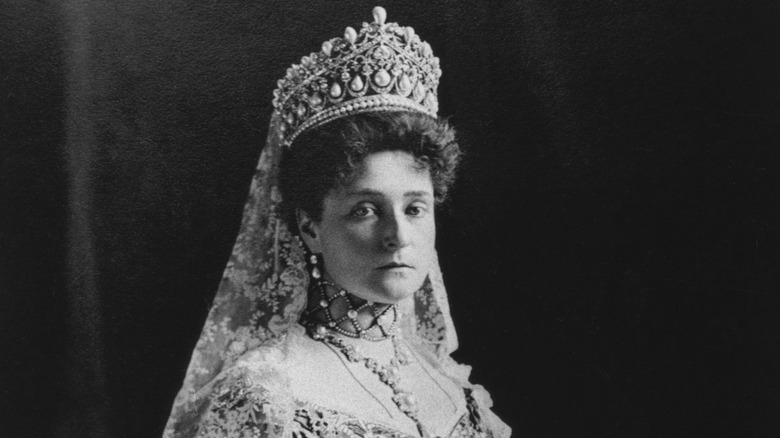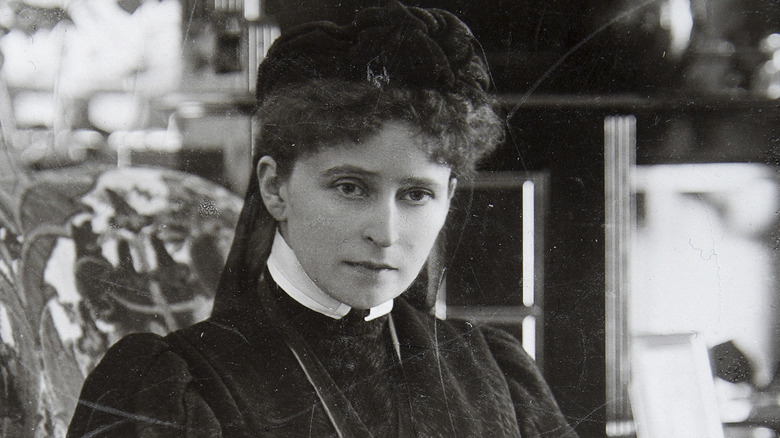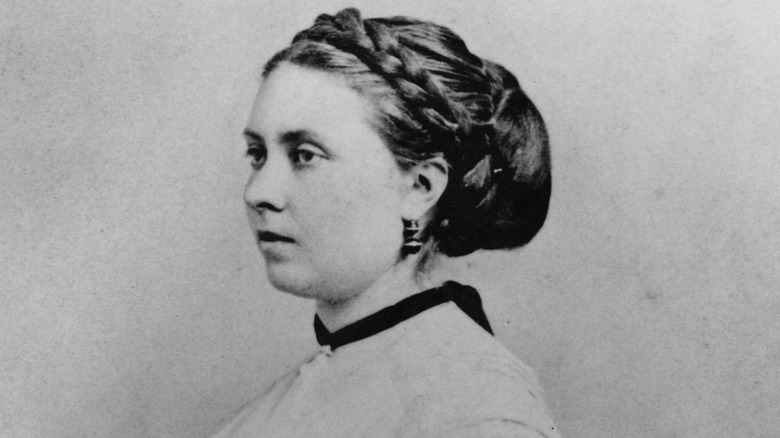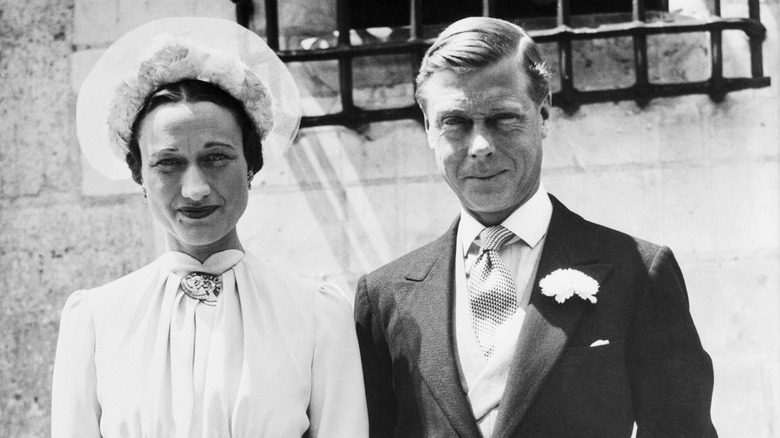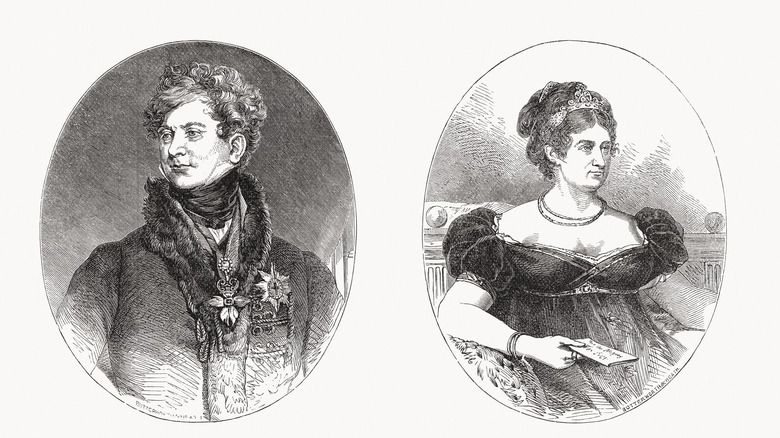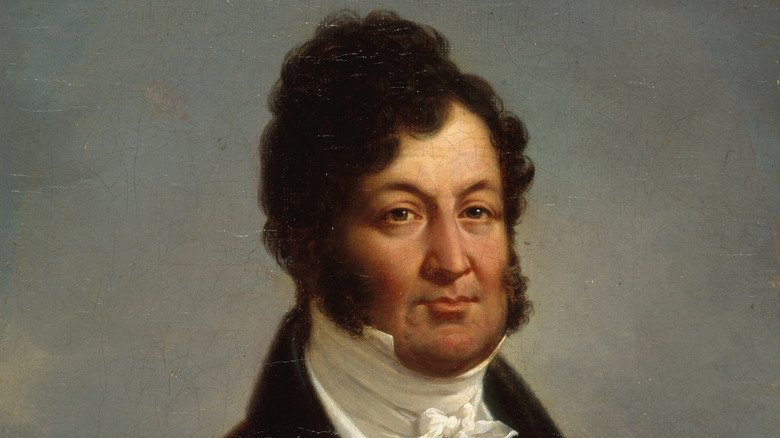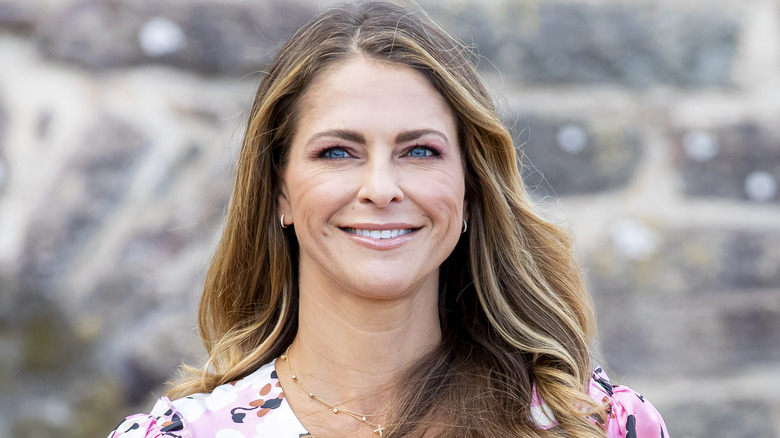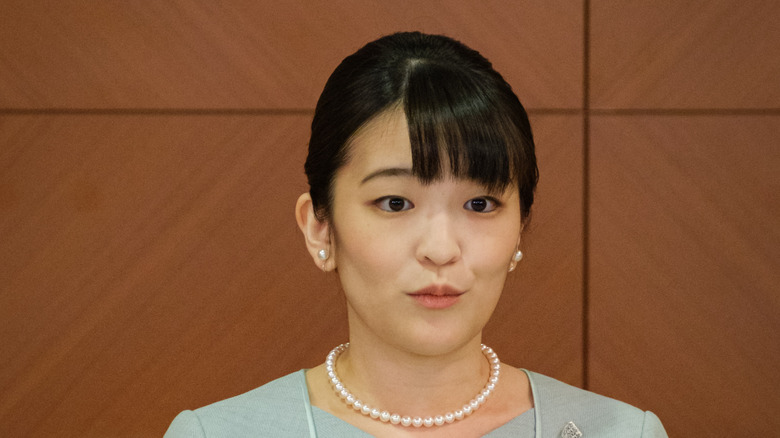Prince Harry Wasn't The Only Royal To Leave His Home Country
When Harry met Meghan in 2016, could anyone have guessed their trajectory? More specifically, could anyone have guessed that less than two years after their lavish 2018 royal wedding, they'd quit the royal family and head across the Atlantic, landing ultimately in Montecito, California?
Well, maybe in hindsight, which, of course, is 20/20, but also it's not like this is the first time that something like this has happened. And, no, we're not even counting the relatively drama-free and ultimately temporary relocations of minor royals like the Princesses Beatrice and Eugenie, both of whom spent time living in the U.S.
What we're talking about is the fact that world history is rife with examples of British royal family members relocating amid scandal or even exile. And it's not just British royal family members, either — although one might argue royal families across Europe feature members of the extended British royal family, thanks to Queen Victoria's prodigious childbearing and enviable matchmaking skills. On the other hand, not all these royals who left their home country are from Europe. Let's take that world tour, shall we?
Princess Alice of Battenberg: Born in the U.K., she never stayed anywhere for long
In 1885, Princess Alice of Battenberg (who, in 1921, would give birth to future Prince Philip, Duke of Edinburgh) was born at Windsor Castle to Princess Victoria of Hesse and by Rhine. She was a great-granddaughter to Queen Victoria. A citizen of the U.K. and frequent guest of the queen at Windsor, Princess Alice grew up in Germany and then married a son of the King of Greece in 1903 when she was just 18. Having become Princess Andrew of Greece and Denmark, she moved to Greece for what she thought would be the rest of her life.
Unfortunately, by 1922, political unrest led the Greek royal family to take refuge outside of Greece. Alice, along with Andrew and their five children, including an 18-month-old Philip, ended up in Paris by way of Italy. During her time in Paris, Alice came to embrace the Greek Orthodox religion, even as her marriage to the former Greek prince deteriorated. In 1930, after the couple had already separated, Alice was diagnosed with schizophrenia and placed in a Swiss sanitarium, as nursing homes were called then.
After her release, she relocated to Greece only to flee again in 1967 following more political unrest. This time, she landed in the U.K., where her son was Queen Elizabeth II's prince consort. Princess Alice lived at Buckingham Palace until her death in 1969.
Prince Philip: Born in Greece, exiled to France, he became the prince consort of Queen Elizabeth II
Prince Philip spent decades as Britain's prince consort. Born in Greece in 1921, the fifth child and the first son of Prince Andrew of Greece and Princess Alice, Philip was seemingly destined to spend his life as a minor member of both the Greek and Danish royal families, not to mention a member of the extended British royal family thanks to his mother's lineage, as discussed above. However, before Philip was even 2 years old, a coup brought down the Greek royal family, forcing Andrew to move his family to Paris.
But Prince Philip never considered Paris his home. In fact, throughout his childhood, he had no permanent home. He was educated in France, Germany, and Scotland and shuffled from family member to family member after his mother was committed to a Swiss hospital in 1930. In 1939, he joined the British Royal Navy. That same year, he was recruited to give the British heir apparent, Princess Elizabeth, a tour of the grounds.
In 1947, the two would marry. In 1952, she became Queen Elizabeth II, and he, the prince consort. And so it came to pass that the exiled Greek and Danish prince became the British queen's "strength and stay," as the queen once said.
Princess Alix, Queen Victoria's granddaughter, became the ill-fated Tsarina of Russia
In the wee hours of July 17, 1918, Empress Alexandra of Russia was murdered along with her husband, Nicholas II, and their five children, at the House of Special Purpose. That was the name the Bolsheviks gave to Ipatiev House, a civilian home they'd taken over and converted into a makeshift prison for the deposed Russian royals. Arguably, however, Alexandra might have avoided this fate had she done as her grandmother, Queen Victoria, wanted.
Born in 1872, Princess Alix was the child of Princess Alice of the United Kingdom. (Alix was the aunt of Princess Alice of Battenberg and a great-aunt of Prince Philip.) Alix was a citizen of Germany, but after her mother's death in 1878, she became close to the queen, who wanted Alix to marry her grandson, Prince Albert Victor of Wales.
The match didn't materialize, but not because Albert Victor, also known as Prince Eddy — and who would later become a Jack the Ripper suspect — died of influenza in 1892. Rather, Alix met and fell in love with Nicholas at the 1884 wedding of her sister, Elisabeth, to Russia's Grand Duke Sergei. Disappointed, the queen nevertheless supported Alix's choice. After marrying in 1894, Nicholas inherited the Russian crown. The rest, as they say, is history.
Princess Alix's older sister, Princess Elisabeth, also married and lived in Russia
The older sister of Alix, Princess Elisabeth, or Ella as she was known, was born in Germany in 1864 and lived there until her 1884 marriage to Grand Duke Sergei Alexandrovich of Russia. Another beloved grandchild of Queen Victoria, she grew up to become one of Europe's most eligible bachelorettes, rebuffing the advances of both the future German emperor, Wilhelm II (her Aunt Vicky's son, as we'll discuss below) and Frederick II, who would one day become Germany's Grand Duke of Baden.
Despite the queen's disapproval, Ella married Sergei in Russia and remained there even after his assassination in 1905. Soon after, the former grand duchess renounced both royal and secular life in favor of entering a convent as a nun in the Russian Orthodox church. However, at the same time that the Bolsheviks began rounding up members of the Russian royal family, they were also attempting to dismantle the church.
Soon, after her sister Alix's family was captured and imprisoned, the Bolsheviks seized Ella's convent and transported her and two other sisters to the city of Alapaevsk. They were detained until July 18, when they were murdered in a mineshaft along with several members of the Russian royal family.
Princess Vicky, the eldest child of Queen Victoria, became the German Empress
One of the men whom Princess Elisabeth might have married, had she not married into the Russian royal family, was Kaiser Wilhelm II of Germany, who inherited the role of German emperor at age 29, when his father, Emperor Frederick III, died in 1888. Wilhelm was the firstborn son of Queen Victoria's namesake and eldest child, Vicky, as well as the queen's first grandchild. But Wilhelm didn't have much of a relationship with his British relatives, in part because he had a dysfunctional relationship with Vicky, according to The Independent.
Nevertheless, Vicky, who was born in 1840 and held the "princess royal" title from 1841, lived her entire adult life in Germany. When she was just 14, she became engaged to the Prussian crown prince, Frederick III, much to the queen's delight. The two were married in 1858 — albeit in England, much to the dismay of some German folk.
Although Vicky remained in close contact with Queen Victoria, including through her extended visits to England, she lived the rest of her life in Germany, even after her husband's death from cancer just months after he ascended the throne in 1888. Unlike Prince Harry and many of the other royal relocations discussed here, Vicky's involved little to no drama. She died of cancer in 1901, the same year as her mother.
The Duke of Windsor: After abdicating, he relocated to France
When Prince Harry relocated to California, his grandmother, Queen Elizabeth II, was not surprised, he told "Good Morning America" in early 2023. After all, he'd been telling her for years of his trepidations about continuing on with this royal role. Nor was it the first time Elizabeth witnessed the fallout of a royal family member's dissatisfaction with constraints imposed by the firm.
When the queen was a child of 10, her uncle, King Edward VIII, abdicated the throne because he did not want the role of monarch if he could not do it with the American divorcee, Wallis Simpson, by his side. And he could not, because the Church of England would not permit him to do so, even morganatically (i.e., unofficially). On December 11, 1936, the king abdicated. The new king, younger brother and former Duke of York, George VI (father of Elizabeth II), made the former king the Duke of Windsor. But his relationship with the royal family was tense, and he almost couldn't find a royal chaplain willing to officiate at his 1937 wedding to Simpson, which took place in France.
France is where the couple made their home, with interim tenures elsewhere in Germany and the Bahamas. They spent little time in England after that, but Edward, who died in Paris in 1972, is interred at Windsor, with Simpson buried by his side.
Queen Caroline of the U.K. spent her final years in Italy, unofficially exiled from Britain
Born in 1768, the German-born Princess Caroline of Brunswick was the daughter of Princess Augusta (one of King George III's siblings). That made Caroline the first cousin of George IV, who married her in 1795 – despite being married already, without his father's approval, to another woman, Maria Fitzherbert.
According to The Washington Post, Caroline had a weird feeling about the situation but nevertheless relocated to England to marry the then-Prince of Wales. Although the two never divorced, their marriage was effectively over by the time their daughter, Princess Charlotte of Wales, was born in January 1796.
After nearly two decades, which included a humiliating investigation into Caroline's private affairs following her estranged husband's accusations of adultery — which were likely frivolous — an arrangement was made whereby the queen would be paid an annual stipend of £35,000 to leave England. From 1814 until her sudden death in 1821, the queen of England was excluded and spent much of her time in Italy. Her daughter, Princess Charlotte, died during labor in 1817.
The last king of France spent a lot of time in exile from his home country
The last king of France wasn't actually Louis XVI, who was executed along with his wife, Marie Antoinette, in 1793 amid the French Revolution. Rather, the French monarchy was reinstated in 1814 when Napoleon I stepped down as emperor. In 1848, the last actual monarch to actually rule France fled the country for a safe space at Queen Victoria's Claremont House. There he remained until his death in 1850.
But it wasn't the first time that Louis-Philippe had lived in exile. Born in 1773, he supported the French Revolution along with his father, a French duke. But in 1793, Louis-Philippe deserted to Switzerland. He remained in exile until 1814, when the hereditary monarchy was reinstated, with his cousin Louis XVIII as king. Louis-Philippe ascended the throne in 1830, following the abdication of Louis XVIII's brother, Charles X.
Well-liked at the outset, Louis-Philippe gradually disappointed the nation, whose economy went into a downward spiral in 1846. After eight assassination attempts and amid another burgeoning revolution, Louis-Philippe abdicated and went to England under the name "Mr. Smith."
Queen Christina of Sweden stole out of her home country, dressed as a man
In 1654, a gentleman who would have looked an awful lot like the newly abdicated Queen Christina of Sweden exited the country for greener pastures elsewhere in Europe. It eventually came to light that this was, in fact, the former queen, who had chopped off her hair and was traveling in disguise before adopting the name Maria Christina Alexandra.
Born in 1626, Christina ruled Sweden from age 6 until her abdication in 1654 (albeit under a regency until she attained adulthood). Her reign was fraught with controversy fueled, in part, by Christina's refusal to rein in her own behavior. Among other things, she spent too much money, she was reckless, and she's even blamed for the untimely death of philosopher Rene Descartes.
By 1651, she was already considering abdication, but it wasn't a done deal until she decided she wanted to convert from the Lutheran faith to Catholicism in 1654. In Sweden, as in England, loyalty and obedience to the state-sanctioned church was a prerequisite for a monarch. But she wasn't cool with that. She did try to regain her throne and monarchies elsewhere, but Christina spent the remainder of her life (she died in 1689) traveling about Europe, shocking locals with her continuing impish ways.
Princess Madeleine of Sweden: The royal who retired to Florida
Swedish Princess Madeleine is, like Prince Harry, the second-born child of the current monarch, King Carl XVI Gustaf. And, just as the Duke of Sussex would do in 2020, Princess Madeleine embarked in 2018 on what was to have been an indefinite stay in the U.S. — specifically in Florida, where she and her husband and three children already had a vacation home. Unlike the Duke of Sussex, however, Princess Madeleine did not make her decision to move stateside amid controversy.
In fact, the family had already spent significant time living in New York City, where Madeleine relocated in 2010 — to work for her mother, Queen Silvia, as a projects manager for the queen's World Childhood Foundation. Then Madeleine met her husband, the British American business owner, Christopher O'Neill, whose childhood was divided between Boston, New York, London, and St. Gallen, Switzerland. The couple's first child, Princess Leonore, was born in New York City in 2014.
The family returned to Sweden in early 2015, then relocated to London later that year — until 2018's move to Florida. In 2019, the king stripped Madeleine's children of their HRH titles, but Tatler maintains Madeleine "welcomed the move." Indeed, come August 2023, Princess Madeleine and family will return indefinitely to Stockholm, where, presumably, Madeleine intends to amp up her royal calendar in a way she was not able to while living abroad.
Prince Joachim of Denmark: When the monarchy got him down, he chose Washington, D.C., instead
Another Scandinavian royal with relocation plans for summer 2023 is Prince Joachim of Denmark, whose new position with the Embassy of Denmark beginning September 1 requires his relocation to Washington, D.C. Like the Duke of Sussex and Princess Madeleine, Joachim is the spare to the heir. And like Madeleine, his children were recently stripped of their royal stylings by the current monarch, Queen Margrethe II. Unlike Madeleine's case, however, many maintain the relocation is the prince's direct response to his children's royal demotion, along with other power struggles he's been having with the Danish royal family.
As with many of the other royal émigrés discussed here, this is not Joachim's first relocation rodeo. He and his family moved to Paris in 2019. But even before that, Prince Joachim had been struggling to chart a course as the royal spare.
In 2021, Royal Central reported that Joachim told the French magazine Point de Vue, "The crown prince simply has to follow the course of events. However, nothing is defined for the second-born son and the person's wife, neither in writing nor in speech." It's enough to make one wonder whether Prince Harry may have started a trend.
Princess Mako of Japan: Moved by love, she relocated to New York
Princess Mako of Akishino, the firstborn child of Japan's crown prince, had a direct line to the crown and comported herself as such from her birth in 1991 — right up until she reached adulthood. That's when she made the controversial decision to attend university in Tokyo. There, in 2012, she met Kei Komuro, a fellow student who wasn't merely a commoner, but actually grew up under challenging financial circumstances.
The two became engaged in 2017, at which point the media frenzy grew almost unbearably intense, leading Komuro to relocate to New York to study at Fordham University School of Law. Not that this created a rift in the couple, who tied the knot in 2021. But the marriage took place outside the royal rubric, with the princess eschewing the traditional royal wedding gift of $1.3 million. And it was followed by the couple's announcing they were moving to New York — sans titles, status, and a royal stipend.
Mako and Kei Komuro live as private citizens in New York City in a one-bedroom apartment, albeit in an upscale building that was constructed in 2017, according to Curbed. Little else is known about the couple other than they have no social media presence. Comparisons to the Duke and Duchess of Sussex, which are often made, seem a bit of a stretch.
